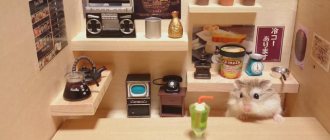4.7
(9)
When starting an aquarium, you need to take into account a lot of nuances so that in the future it pleases the eye and does not cause problems. Among the mandatory elements that a home underwater world should be equipped with is an aquarium lid.
A ready-made version can be bought at a pet store or ordered directly from a specialist. But many people are also interested in a DIY aquarium lid. It’s not surprising, because this design is more affordable, and if its manufacture is approached responsibly, it can last no worse than its store-bought counterpart.
Why is it better to make it yourself?
- Aquarists purchase tanks of different sizes for fish. But not a single standard model will fit the original container of an unusual shape.
- The standard one is equipped with only two electric lamps. This is not always enough to fully illuminate the tank. The lack of light causes the fish to experience discomfort.
- Factory models mainly consist of several parts. Every time you change the water or clean the tank, you will have to disassemble it, which is not very convenient.
- The lid is located very low above the water level. Then the lamps begin to heat it up - by five degrees or more. And also, due to the low location of the structure, condensation begins to form.
- Standard models have too narrow compartments for tubes and wires. Therefore, it is difficult to install a mechanism that takes water for purification.
- Factory models are not equipped with ventilation systems. And so that the fish do not suffer due to lack of oxygen, you will have to periodically open the aquarium.
Based on these reasons, we can conclude: it is better to make the roof for the house of the wards yourself.
Video
The video shows the nuances of working with plastic panels. Author Aquaman, Aqua Man channel - Aquarium.
Was this article helpful?
Thank you for your opinion!
The article was useful. Please share the information with your friends.
Yes
No
X
Please write what is wrong and leave recommendations on the article
Cancel reply
Rate the benefit of the article: Rate the author ( 1 vote(s), average: 5.00 out of 5)
Discuss the article:
How to make a lid for an aquarium
Before you make an aquarium lid with your own hands, it’s worth figuring out what the end result will look like. You need to find out the dimensions of the sides of the container and the necessary elements. It’s also better to make a drawing: it will be much easier to work.
Example drawing for a cover
It is important to think about cleaning the tank: depending on the location of the parts, cleaning it later may be inconvenient. The material must be waterproof, resistant to elevated temperatures, safe and environmentally friendly. Experience shows that foamed PVC is the best option.
Before assembling the structure, all parts must be degreased to avoid problems in the future.
The side walls and the top are created separately and then assembled. They are glued together with glue - not just any glue is suitable for PVC, but in this case you can use “liquid nails” - that’s what construction glue is called. Immediately before gluing, it is better to take measurements of all the parts again and check if they match in size. If everything is correct, you can proceed to connecting the parts. It is very important to ventilate the work area when gluing so as not to be poisoned by glue fumes.
Preparing for work
Making your own lid is easy. The main thing is to choose the right material, calculate its quantity and dimensions of the finished product so that it sits tightly on the container and can withstand the load.
You will first need to take measurements, accurately taking the parameters of each wall, as well as the desired height. In order not to get confused in the future, it is better to make a drawing, which will indicate in detail and clearly which segment will go where.
Also important is the form itself. She can be anything. If this is a lid for a corner aquarium, then, accordingly, you need to calculate how it will sit. But even for a standard rectangular container you need to think through everything carefully, namely:
- How the walls will contact the glass;
- Are ventilation holes necessary?
- Will there be a need for doors through which access to the aquarium will be simplified for feeding, care, etc.;
- Where the holes for the filter, compressor and other equipment will be located.
In addition, for manufacturing you will need certain accessories and tools:
- Roulette;
- Pencil;
- Stationery knife;
- The material itself (PVC, laminate);
- Corners;
- Glue (optionally, liquid nails).
We recommend reading the article: How to make an aquarium with your own hands
Use of other materials
The aquarium cover can be made from other materials: PVC sheets, laminate boards that were left at home after the renovation was completed; ordinary plastic or panels for wall coverings, glass or plexiglass.
- PVC weighs little and is easy to process and is very durable. But if the required area is too large, the body must be strengthened by attaching ribs so that it does not sag.
- Wood - laminate, lining, plywood, chipboard - has proper hardness and is easy to process. However, it is not cheap and weighs a lot - the walls of the tank may not withstand the pressure of water and the weight from above. In addition, wood gets wet easily, and you will have to tinker with it a lot, using varnish and silicone sealant.
- Wall panels have three width standards: 100 mm, 250 mm and 370 mm. Therefore, you can assemble anything from them into any container. Wall panels are easy to find (they are sold in hardware stores) and material of any color can be purchased inexpensively. Both vertical and horizontal reinforcements are made for them. The panels are light, but fragile. If something sharp or heavy falls on it, it will break through. And also not any plastic is suitable for an aquarium lid.
- The glass is secured during operation using aquarium sealant. It does not become cloudy over time and does not require painting. But there are many more disadvantages: glass weighs a lot, it is very fragile and requires complex processing.
- Plexiglas is much stronger than ordinary glass and looks interesting. Only the work process is quite complicated: the plexiglass is bent with a blowtorch or an industrial hair dryer. The material is fastened with special glue made from trichloroethane and plexiglass sawdust, aged for 12–20 hours.
Purpose
Aquarium lids serve not only as decorative items. They perform a number of useful functions, without which it is difficult to provide underwater inhabitants with the necessary conditions:
- Significantly reduce the rate of liquid evaporation. The period between top-ups increases.
- They serve as a reliable protective barrier against foreign objects entering the tank.
- Protects against pets, especially curious cat paws. Relevant for houses where parrots, cats, and dogs are kept.
- They are supplemented with the necessary elements, including lighting fixtures, accessories for a filter and an aerator.
- They prevent fish from accidentally jumping out of the aquarium, keeping them alive.
- Allows you to maintain the desired temperature.
Thus, the lid helps maintain the established balance of the ecosystem and increases the safety of the inhabitants of the aquarium.
Ready-made options
Of the ready-made structures, we recommend the one known in Russia. It offers customers a variety of options - rectangular and panoramic aquariums. Available in small ones - 40x25 cm, and designed for a large tank - 120x40 cm, and rare 100x40 cm. There is almost any lid for a panoramic aquarium - from 50x30 to 120x40 cm. Color is not only black or gray, but also in the tone of oak, walnut, alder and others.
produces simple, inexpensive designs with a five-year warranty. engages in custom-made lid manufacturing, creating designs of any complexity.
Manufacturing process
First you need to measure the dimensions of the tank to determine the size of the product. If you have the makings of an engineer, you can even make a simple drawing. It is necessary to consider the convenience of the design, the possibility of its easy removal for cleaning the fish house and installing new decorations.
Required Tools
You need to prepare everything you need in advance so as not to be distracted while working.
You will need:
- For notes – pencil or marker, ruler, square.
- Cutting tools – knife, scissors, jigsaw, glass cutter, cutter.
- Screwdriver or drill.
- Substances for adhesion - glue, a sealant gun, the sealant itself, solder for glass.
It is equally important to find a perfectly flat surface to work on (this is especially true for plexiglass).
Selection of materials
From the above materials it is easy to choose the most suitable one.
Important selection criteria:
- tank size;
- quantity of equipment;
- the height of the lid - for some fish it must be significant in order to maintain a large layer of air;
- work skill and ease of manufacture;
- availability and price of material;
- ease of use;
- aesthetics.
Most experienced aquarists prefer to use PVC lids, wall panels, laminate, varnished plywood and chipboard for the manufacturing process.
For a panoramic aquarium
The main difficulty in this case is the curved front wall. There are two options to get around this problem - make a curved frame or a frame with convex platforms. Let's consider production in both cases.
Product with a bent frame - step-by-step instructions:
- The material you can use is plywood, lining, plastic or laminate.
- It is necessary to cut out the main parts: the top convex, back and sides.
- Bend the front part by heating the plastic or plexiglass with a hairdryer. For wood, you need to make transverse cuts with a grinder, with a depth of at least half the thickness of the workpiece. The greater the curvature, the smaller the gaps between cuts should be.
- Glue the strip and sides to the lid, having previously degreased it. Secure the corners and support bolts at a distance of three centimeters above the bottom edge.
- Make a hatch for feeding, process the edges.
- Cover the black material with foil or other reflective covering.
- Install lamps, aerator and other equipment.
The manufacturing process is not simple and is unlikely to be suitable for a novice aquarist. Let's consider the following, easier option.
Cover with platforms:
- Any material can be used.
- Cut out rectangular blanks, which will serve as the base.
- Secure the sides with glue or screws.
- Attach pre-cut platforms of the desired curvature.
- Make holes for feeding and wires.
- Mark and hang lamps and equipment.
- Paint or tape the lid.
Remember that you need to connect the equipment only when the product is completely ready.
For round tank
In this case, there are also two options: double-layer lids and with a side.
Rules for making a two-layer variation:
- Any materials can be used.
- Measure the hole of the flask, cut out two circles - the first is the same diameter, the second is 3-4 centimeters larger.
- Glue both parts, attach the handle, cut holes for the ventilation wires and wires.
The second option will require skill in working with plastic. Sometimes you can't do without an assistant.
Lid with side - step-by-step instructions:
- Cut a circle 1-2 centimeters larger than the aquarium flask, cut holes in it and attach a handle.
- Make a rectangular strip equal to the circumference. The most difficult thing in this case is to bend the material, giving it a perfectly round shape.
- Glue all the received parts, decorate the lid and install the equipment.
The first option is easier to manufacture, the second is more aesthetically pleasing and looks “expensive”, just like a purchased product.
How to make a lid with a filter
Sometimes the filter needs to be installed not on the side, but on the top. This arrangement should be taken into account when manufacturing the protective cover.
Sequence of actions:
- Cut out the lid parts and assemble the structure.
- Drill a hole in the lid for a special size mount for a specific filter. Place the filter on a special platform, which can be made from a small square sheet.
- Check if the device is installed correctly. If the tank is large, it is necessary to make a separate hatch for cleaning the filter.
It is advisable to provide for the installation of the filter before purchasing it.
Price issue
The cost depends greatly on the type of material.
Here are rough estimates for a panoramic container with dimensions of 60x30 cm and a lid height of 10 cm:
- PVC - 1500-2000 rubles per sheet, 100 rubles for glue, paint and film for gluing. Total – 2000-2200 rubles.
- Plastic panels. Four parts 10 by 300 centimeters, glue and decor - a total of about 600 rubles.
- Laminate - three boards of 130 cm - 600 rubles. The same amount is needed for sealant and liquid nails. The result is at least 1200 rubles.
- Lining. A sheet along with wood varnish, liquid nails and sealant will cost 1000 rubles.
- Plywood will cost a little more - 1200-1300 rubles.
- Plexiglas and glue are inexpensive. This “pleasure” will cost only 500 rubles.
- Glass (one sheet) and glue cost about 600 rubles.
For a round aquarium with a diameter of 30 centimeters, everything will cost the same. For a panoramic tank with dimensions of 80x53 cm, the above cost must be multiplied by a coefficient equal to 1.5-1.6.











